 Software Tutorial
Software Tutorial
 Office Software
Office Software
 Detailed explanation of the steps to create an Excel column chart
Detailed explanation of the steps to create an Excel column chart
Detailed explanation of the steps to create an Excel column chart
How to create a histogram in EXCEL
First make a pivot table, and then make this chart.
Suppose A is the name and B is the age. 100 lines in total.
1. Select cells A1:B100, execute "Data" - "Pivot Table and Pivot Chart", select "Pivot Table" for the report type you want to create, click Next, the selected area is: "Sheet1!$A$1:$B$100", click Next, click Finish.
Drag the item "Name" to the row area of the Pivot Table, and drag the item "Age" to the column area of the Pivot Table (as shown in Figure 1).
Place the mouse cursor in the cell of the age item, and then select "PivotTable" - "Group and Display Detailed Data" - "Combine" in the "PivotTable" toolbar (see Figure 2).
3. Enter 10 for “Start at”; enter 60 for “End at”; enter 10 for “Step Size” and click “OK”.
That is: count the number of people aged 10-60, and use 10 years as an age group. (As shown in Figure 3)
4. In the "Pivot Table" toolbar, click the "Chart Wizard" icon to get the chart you need. (As shown in Figure 4)
How to use Excel software to create a Pareto Chart
1. As shown in the figure below, the number of each defective item is counted, and the defective rate of each defective item can be obtained. But it looks very messy at this time and is far less intuitive than the arrangement chart.
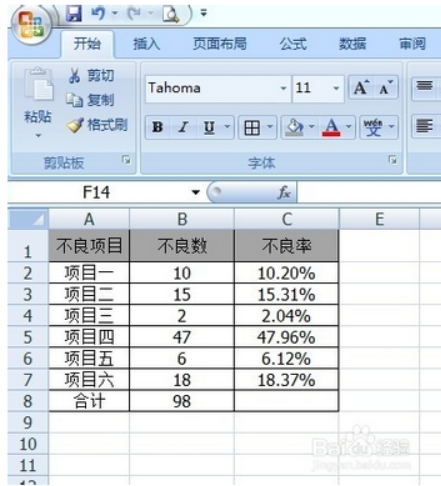
2. Next, calculate the cumulative defective rate (that is, the defective rate of each defective item is accumulated item by item), as shown below. Note: The first item and the total number of the sum must use "absolute reference". At this time, you can directly drop down without calculating one by one.
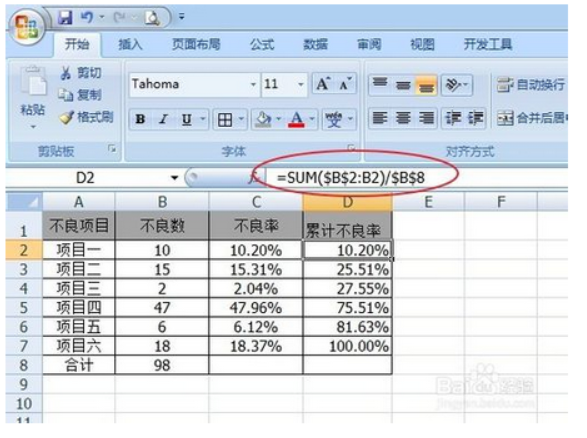
3. At this time, the cumulative defective rate is sorted in descending order, and the chart stage is completed.
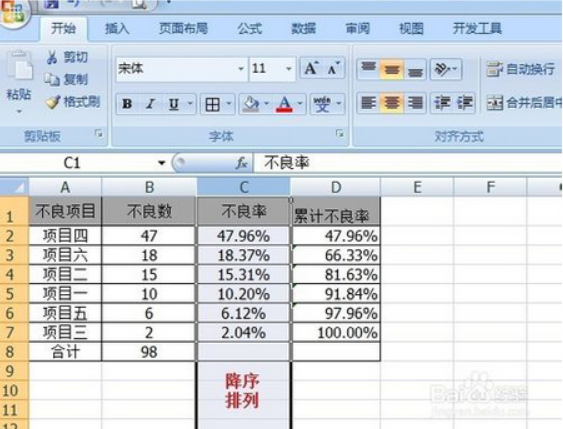
4. Insert a blank histogram, as shown below:
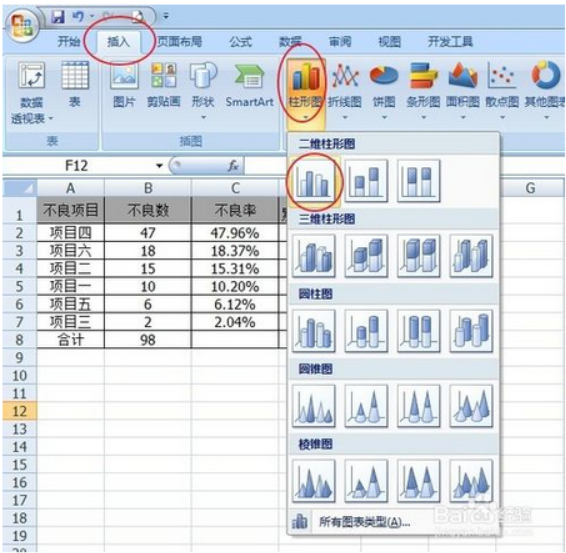
5. Select the blank chart area, right-click - "Select Data", select "Series Name" and "Series Value" (select the corresponding data content in the corresponding input box), click "Horizontal (Category) Axis" Click "Edit" of "Tab" and select the content of the horizontal axis (here, select item four - item three).

6. Press step 5 to add the cumulative defective rate: "Select data" - "Add".
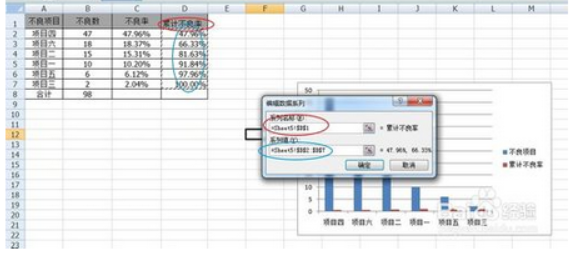
7. After adding the cumulative defective rate, select the histogram of the cumulative defective rate, right-click - "Change Series Chart Type" - select "Line Chart".

8. Select the line chart of the cumulative defective rate, right-click - "Set Data Series Format", and select the "Secondary Axis" as the coordinate axis of the line chart. After selecting, select the axis area, right-click - "Set Axis Format", and modify the axis format (for example, the maximum value of the cumulative defective rate is 100%).
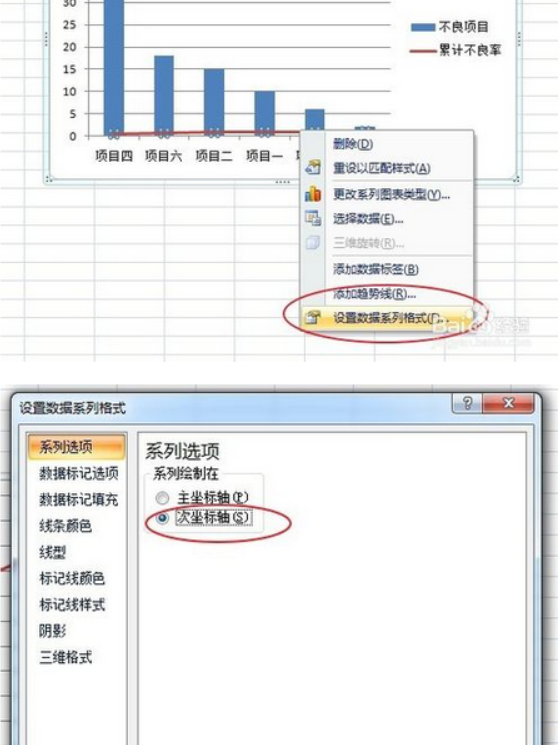
9. At this point, the arrangement chart has been basically completed.
Next, make some small optimizations and adjustments, such as selecting a corner of the chart to adjust the chart size, "Add data label", and set the chart layout: select the chart - "Design" - "Chart Layout" and adjust the column spacing , adjust the graphic background or color, etc. Everyone can explore slowly.
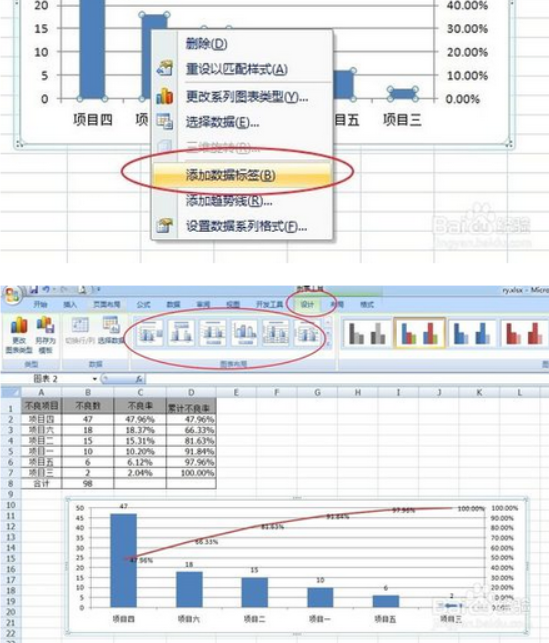
10. The final example of a Pareto Chart.
It can be clearly seen from the picture: item four is the main factor! OK!

The above is the detailed content of Detailed explanation of the steps to create an Excel column chart. For more information, please follow other related articles on the PHP Chinese website!

Hot AI Tools

Undresser.AI Undress
AI-powered app for creating realistic nude photos

AI Clothes Remover
Online AI tool for removing clothes from photos.

Undress AI Tool
Undress images for free

Clothoff.io
AI clothes remover

Video Face Swap
Swap faces in any video effortlessly with our completely free AI face swap tool!

Hot Article

Hot Tools

Notepad++7.3.1
Easy-to-use and free code editor

SublimeText3 Chinese version
Chinese version, very easy to use

Zend Studio 13.0.1
Powerful PHP integrated development environment

Dreamweaver CS6
Visual web development tools

SublimeText3 Mac version
God-level code editing software (SublimeText3)

Hot Topics
 How to Create a Timeline Filter in Excel
Apr 03, 2025 am 03:51 AM
How to Create a Timeline Filter in Excel
Apr 03, 2025 am 03:51 AM
In Excel, using the timeline filter can display data by time period more efficiently, which is more convenient than using the filter button. The Timeline is a dynamic filtering option that allows you to quickly display data for a single date, month, quarter, or year. Step 1: Convert data to pivot table First, convert the original Excel data into a pivot table. Select any cell in the data table (formatted or not) and click PivotTable on the Insert tab of the ribbon. Related: How to Create Pivot Tables in Microsoft Excel Don't be intimidated by the pivot table! We will teach you basic skills that you can master in minutes. Related Articles In the dialog box, make sure the entire data range is selected (
 If You Don't Rename Tables in Excel, Today's the Day to Start
Apr 15, 2025 am 12:58 AM
If You Don't Rename Tables in Excel, Today's the Day to Start
Apr 15, 2025 am 12:58 AM
Quick link Why should tables be named in Excel How to name a table in Excel Excel table naming rules and techniques By default, tables in Excel are named Table1, Table2, Table3, and so on. However, you don't have to stick to these tags. In fact, it would be better if you don't! In this quick guide, I will explain why you should always rename tables in Excel and show you how to do this. Why should tables be named in Excel While it may take some time to develop the habit of naming tables in Excel (if you don't usually do this), the following reasons illustrate today
 You Need to Know What the Hash Sign Does in Excel Formulas
Apr 08, 2025 am 12:55 AM
You Need to Know What the Hash Sign Does in Excel Formulas
Apr 08, 2025 am 12:55 AM
Excel Overflow Range Operator (#) enables formulas to be automatically adjusted to accommodate changes in overflow range size. This feature is only available for Microsoft 365 Excel for Windows or Mac. Common functions such as UNIQUE, COUNTIF, and SORTBY can be used in conjunction with overflow range operators to generate dynamic sortable lists. The pound sign (#) in the Excel formula is also called the overflow range operator, which instructs the program to consider all results in the overflow range. Therefore, even if the overflow range increases or decreases, the formula containing # will automatically reflect this change. How to list and sort unique values in Microsoft Excel
 How to Format a Spilled Array in Excel
Apr 10, 2025 pm 12:01 PM
How to Format a Spilled Array in Excel
Apr 10, 2025 pm 12:01 PM
Use formula conditional formatting to handle overflow arrays in Excel Direct formatting of overflow arrays in Excel can cause problems, especially when the data shape or size changes. Formula-based conditional formatting rules allow automatic formatting to be adjusted when data parameters change. Adding a dollar sign ($) before a column reference applies a rule to all rows in the data. In Excel, you can apply direct formatting to the values or background of a cell to make the spreadsheet easier to read. However, when an Excel formula returns a set of values (called overflow arrays), applying direct formatting will cause problems if the size or shape of the data changes. Suppose you have this spreadsheet with overflow results from the PIVOTBY formula,
 How to change Excel table styles and remove table formatting
Apr 19, 2025 am 11:45 AM
How to change Excel table styles and remove table formatting
Apr 19, 2025 am 11:45 AM
This tutorial shows you how to quickly apply, modify, and remove Excel table styles while preserving all table functionalities. Want to make your Excel tables look exactly how you want? Read on! After creating an Excel table, the first step is usual
 Excel MATCH function with formula examples
Apr 15, 2025 am 11:21 AM
Excel MATCH function with formula examples
Apr 15, 2025 am 11:21 AM
This tutorial explains how to use MATCH function in Excel with formula examples. It also shows how to improve your lookup formulas by a making dynamic formula with VLOOKUP and MATCH. In Microsoft Excel, there are many different lookup/ref
 How to Use Excel's AGGREGATE Function to Refine Calculations
Apr 12, 2025 am 12:54 AM
How to Use Excel's AGGREGATE Function to Refine Calculations
Apr 12, 2025 am 12:54 AM
Quick Links The AGGREGATE Syntax






